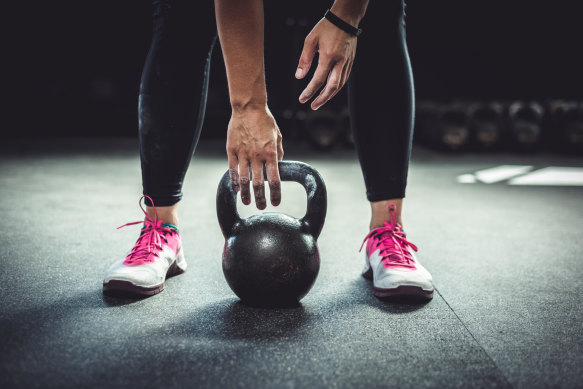How low can we go is a question that has fascinated exercise researchers in recent years.
And that is because less than half of Australian adults manage the lowest recommended threshold of physical activity, which is 30 minutes, five days a week. Even fewer (about 40 per cent) do some form of strength training twice a week.
How low can you go? We don’t need to do much, but the type of movement matters, according to new research.Credit:Alamy
These statistics have inspired the latest work of Ken Nosaka, an exercise and sports science professor at Edith Cowan University, who wanted to know what is the least amount of exercise we can do to be healthy and fit?
We certainly don’t have to smash ourselves at the gym, but we have to do something regularly, he found.
In January, Nosaka published a study that found just three seconds of squeezing our arm muscles as hard as we can five days a week for four weeks can improve arm strength by nearly 12 per cent.
Still, he wondered whether you had to do it every day. Could you condense the exercise into one or two big sessions each week? He also wondered whether multiple rounds of the same exercise were necessarily better?
So, for a new study, Nosaka divided sedentary university students into three groups. The first group did six eccentric bicep contractions a day for five days a week; the second did all the curls (30 in total) in one session a week; while the third did just six curls in one session a week.
By the end of four weeks, the first group improved their arm strength more than 10 per cent and their muscle size by about five per cent. The second group showed no improvement in arm strength but had a similar increase in muscle size as the first group, while the third group didn’t improve on either measure.
It suggests, Nosaka says, that it is the frequency of muscle stimulation that is important, not necessarily the volume of the exercise.
“One contraction a day enough for brain to go ‘OK there’s the stimulus’.”
Muscle strength and mass are an important factor for health, Nosaka says.
“A decrease in muscle mass is a cause of many chronic diseases such as cardiovascular disease, type 2 diabetes, some cancers, dementia, plus musculoskeletal problems such as osteoporosis.”
He adds: “If you maintain muscle mass, you maintain independence and health span.”
Professor Corinne Caillaud, an exercise physiologist at the University of Sydney’s Charles Perkins Centre, says the research is interesting, but adds that the advice to spread our activity across the week is not new.
“We could think that a similar number of repetitions will produce the same effect whatever the training regime, but this is without accounting for muscle fatigue when doing a larger number of repetitions,” she explains.
This means that the quality of the movement, and muscle work, is superior when the training load is spread over multiple days rather than compressed into one session.
Nosaka’s previous research has found that the type of exercise performed in the study – eccentric muscle contractions, like lowering a kettlebell slowly, the downward phase of a bicep curl, walking downhill or even sitting down very slowly – is better for building strength than concentric contractions.
While they don’t fully understand why, he says we can lower more than we can lift, eccentric exercise fatigues us less, and it engages more of the brain.
“Going down is better to improve muscle function and other parameters for health,” Nosaka says. “It strengthens tendons and ligaments… and myokines [proteins that affect insulin sensitivity and cholesterol] are induced more in eccentric contractions than concentric.”
Caillaud explains that there is research to suggest that eccentric exercise may also lead to quicker muscle adaptations “because this type of muscle contraction is known to generate muscle damage stimulating muscle repair and growth”. However, she says there is the risk of causing too much damage, so she cautions people against doing this type of exercise exclusively.
Rather, adding some eccentric exercise into our day and to our existing physical activity regime can benefit all of us.
Nosaka recommends lifting a heavy dumbbell with two hands, but lowering it slowly with one, sitting down using one leg or sitting into our chairs slowly every time.
“Even when you go to the toilet, you can strengthen your muscles every time you sit down,” says Nosaka, who is in his 60s, plays tennis twice a week and always sits down slowly.
For those not doing any resistance training, this is a good place to start, he says. As for weekend warriors, Nosaka says all exercise “is great”. But, he adds:
“In addition to weekend exercise, do a small amount every day. If you can only find one minute in a day, you can do 20 [three-second muscle contractions]. That can improve strength. That’s very encouraging.”
Make the most of your health, relationships, fitness and nutrition with our Live Well newsletter. Get it in your inbox every Monday.
Most Viewed in Lifestyle
From our partners
Source: Read Full Article

